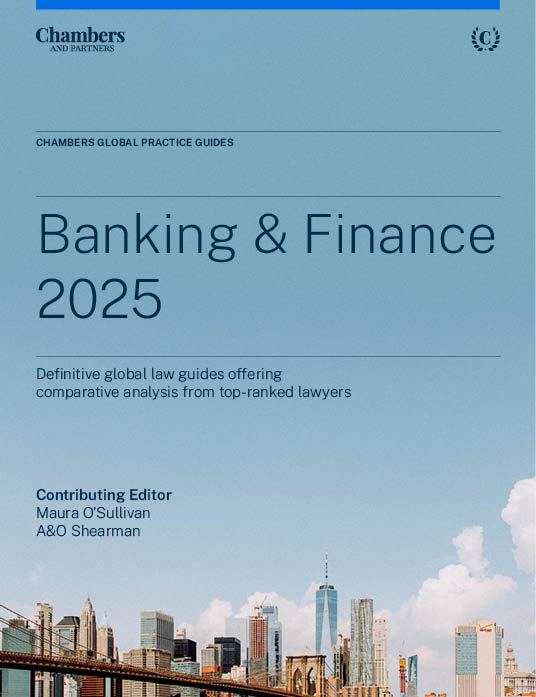
Banking & Finance 2025
The Banking & Finance 2025 guide covers over 40 jurisdictions. The guide provides the latest legal information on the loan market in each jurisdiction covered, including the impact of global conflicts and ESG lending; loan structuring and documentation, including restrictions on foreign lenders; tax issues; guarantees and security; enforcement; bankruptcy and insolvency; and project finance.
Last Updated: October 09, 2025
Compare law and practice by selecting locations and topic(s)
Select Locations

Select Topic(s)

Please select at least one location and one topic to use the compare functionality.
Overview: Investor Demand Drives an Active Market
To date in 2025, global leveraged finance activity has been characterised by cautious optimism, underpinned by the expectation of a gradual reduction of policy interest rates and monetary easing. Market participants are closely monitoring the impact of persistent geopolitical tensions and evolving trade policies. The beginning of 2025 saw an increase in M&A-related loan activity compared to H2 2024 as well as sustained high volumes of repricings, refinancings and dividend recapitalisations. However, momentum faded as the year progressed, especially in March, due to increased macroeconomic uncertainty, particularly around the potential impact of tariffs and global capital market volatility. The return of protectionist trade measures, particularly in the USA, the potential for retaliatory actions, and the slower than expected reduction in interest rates in 2025 (with central banks (in particular, the US Fed) signalling a “higher for longer” approach) have introduced increased volatility. This environment is expected to keep overall funding costs elevated for borrowers and may limit the pace of new issuance, especially in the context of M&A and leveraged buyout activity, which has yet to fully recover to pre-pandemic highs. The macroeconomic and political uncertainties that dampened market activity during the second half of 2022 and throughout 2023 and 2024 have not abated and have now increased post-March 2025 as a result of the adoption of American protectionist policies.
Debt financing options available to borrowers in 2025 have continued to rebalance with the return of the broadly syndicated market following the slowdown it experienced in the second half of 2022 and in 2023, and the continued expansion and strength of private credit. As a result, borrowers have increasingly sought to capitalise on the competitive tension between the syndicated and private capital markets by opting to run some transactions on a dual-track basis with both syndicated and private credit options.
Borrowing costs remain elevated in 2025, and there is still a valuation gap in the M&A market between the prices at which sellers are willing to part with their assets (often purchased at high multiples) and the price at which purchasers are willing to buy. The scarce exit opportunities for private equity sponsors are apparent in statistics showing that the average hold time for portfolio companies has steadily increased since 2019 (Pitchbook). In response, private equity sponsors have increasingly turned to alternative strategies to generate returns for LPs, with issuances of leveraged loans for dividend recapitalisations remaining at elevated levels in 2025 from 2024.
The market outlook currently remains tentatively hopeful, with interest rates expected to come down in the second half of the year, alongside promising signs from private equity sponsors of improved M&A pipelines as they look to deploy accumulated dry powder. The secondary loan market remains stable supported by high loan investor demand.
Trends in an Uncertain Market
In the USA, the first half of 2025 experienced a rise in M&A-related loan issuance, with a more balanced mix between new M&A-related loan issuances and refinancing or repricing transactions. Of this, M&A-related loan issuance in the USA reached USD109.9 billion, up 44% from USD76.1 billion in the first half of 2024. US LBO loan issuance alone was USD45.1 billion, a 28% increase from USD35.3 billion in the prior year-to-date period, while non-LBO M&A loans totalled USD64.7 billion, up 58% from USD40.9 billion. Refinancing activity in the US markets, however, declined to USD157.8 billion, down 27% from USD217.0 billion in the first half of 2024, reflecting a shift away from the record refinancing and repricing volumes that characterised the prior year. Dividend recapitalisation loan issuance in the USA remains sustained but also moderated, totalling USD38.7 billion, a 14% decrease from USD44.7 billion in the same period of 2024.
In the European market, refinancing remained the largest use of proceeds in H1 2025, with volume at a similar level to that seen in the same period in 2024. As in the USA, overall M&A-related loan volume has been higher as a percentage of primary issuance – and in Europe at least, we have seen LBO activity represent a higher proportion of overall M&A than it did in the same period last year. In absolute terms, EUR24.6 billion of M&A-related issuance in H1 2025 is more than the market saw in all of 2024 (Pitchbook).
In 2025, the competitive interplay between the broadly syndicated loan (BSL) market and the private credit market continues to shape pricing, covenant structures, and deal flow. Throughout 2024 and into 2025, the supply/demand imbalance in both the BSL and private credit markets has kept significant downward pressure on interest rate margins and overall pricing terms. Borrowers have been able to obtain favourable pricing and looser covenant terms in both the broadly syndicated and private credit markets. In the BSL market, cov-lite structures remain the norm, with roughly 90% of new deals in the USA featuring them.
Direct lending clubs, which help facilitate larger transactions when the BSL market is less accessible, are prominent in 2025 and allow private credit providers to pool resources for multi-billion-dollar deals, especially when market volatility restricts BSL access. As competition with syndicated lenders continues, club deals offer sponsors certainty, speed, and flexible structuring, including features such as delayed-draw term loans and payment-in-kind options, making them a preferred choice for large financings that previously would have relied on BSLs or high-yield bonds.
In the USA, direct lending made up about 49% of new LBO loan volume in Q2 2025, down from 56% in 2024 and 88% at its 2023 peak. In Europe, most LBOs by number are still funded by direct lenders, though BSL loans tend to be larger on average. With increased competition from the BSL market, private credit providers in both the USA and Europe are seeking alternative structures to maintain returns, for example, arranging holdco PIK financings in some capital structures.
In 2025, the US market for lower-rated borrowers has continued its resurgence, though with some moderation compared to the sharp risk-on sentiment seen in 2024. Borrowers with a B- rating or lower from at least one credit rating agency remain a significant portion of refinancings, but their share has stabilised as investor risk tolerance finds a new equilibrium accounted for. In the first half of 2025, B- and lower-rated issuers accounted for approximately 45% of refinancing volume, a slight decrease from the 51% peak in Q2 2024 but still well above the levels seen in 2023.
Syndicated delayed draw term loans (DDTLs) have also become an increasingly prominent feature of US deals and are especially attractive to private equity sponsors pursuing buy-and-build strategies. While DDTLs have long been a staple of private credit, their adoption in the syndicated market has accelerated, with a growing share of large-cap US transactions now including a DDTL component. This shift reflects both the competitive pressure from private credit and the desire of sponsors for greater flexibility and certainty of execution. While DDTLs have been seen in some European BSL deals, they are not as popular as in the USA and have remained the “sweet spot” for the private credit markets.
Dividend recapitalisation activity soared in the US market to USD25.3 billion in the first quarter of 2025 alone, more than double 2024 Q4’s USD11.3 billion. The volume of dividends taken out of businesses by private equity sponsors has also risen in Europe, with EUR14.5 billion of total loan issuance supporting dividend recaps in H1 2025, compared to EUR8.5 billion during the same period in 2024 (Pitchbook). Further, as private equity sponsors seek alternative exit strategies, particularly where their investment time frame is coming to an end, portability features (ie, where a change of control will not trigger an event of default or mandatory prepayment subject to certain conditions) are increasingly making their way into credit documentation.
As riskier borrowers have returned to the market, the average leverage ratio for non-investment-grade borrowers in 2025 in the USA is 4.9x (through June), up slightly from 4.7x in 2024 (reflecting the full calendar year). While this marks a continued upward trend, leverage remains below the 2021 peak of 5.3x, reflecting a still-cautious approach by US lenders compared to the pre-pandemic era (PitchBook | LCD). Despite some tightening in credit spreads, high benchmark rates have kept interest costs elevated. Even though interest spreads trended down in 2024, the continued high benchmark rates have led to an average interest coverage ratio of 3.1x (LCD) in 2024 and 3.0x in 2025 (through June). Overall, the 2025 market environment continues to favour borrowers in terms of covenant flexibility and leverage capacity, but the pressure from high rates is placing greater scrutiny on coverage metrics and underlying credit quality. In Europe, first lien debt is on average levered at 4.71x, but transactions with leverage of 6x or higher represented the lowest percentage of deals since 2016 (LCD).
Liability management transactions (LMTs) remain a prominent feature of the US leveraged finance landscape, as borrowers continue to grapple with elevated borrowing costs, ongoing liquidity concerns and a looming maturity wall, particularly among lower-rated issuers. In the USA, the pace of LMTs – including uptiering, drop-downs, and double-dip structures – has remained robust, with market participants expecting distressed LMTs to at least match, if not moderately exceed, the record-setting pace of 2024. This ongoing activity is driven by constrained exit opportunities for sponsors and the need for flexibility in managing capital structures (PitchBook | LCD; Creditor Rights Coalition). In Europe, although there are examples of LMTs, they remain relatively rare and the ability to execute such transactions out of court varies depending on the jurisdiction and legal framework.
Lenders are increasingly adding protections in documents to address risks from looser terms and covenants. Co-operation agreements have become a common tool for lenders to minimise the risk of LMTs, but borrowers are attempting to push back by including anti-cooperation language in documents, which is, in turn, strongly resisted by lenders. Legal developments in case law have not slowed the momentum of LMTs as once previously thought. For example, the Fifth Circuit Court of Appeals ruling in Serta Simmons, in December 2024, finding the 2020 up-tiering transaction was not a valid “open market purchase” under the credit agreement and that related indemnities in the Chapter 11 plan were not permitted, has caused parties to pivot to other provisions but has not stopped uptiering transactions (eg, Better Health). According to reporting as of this date, LMTs are on pace to surpass last year.
In 2025, sustainability-linked leveraged loan facilities continue to grow and tie the interest margin charged to compliance with certain key performance indicators (KPIs). Global issuance of sustainability-linked leveraged loans in 2025 remains robust but did not surpass the record Q1 volumes achieved in 2024. Standard practices emerging include independent third-party verification of compliance with KPIs and fixed timeframes for KPI implementation when flexible ESG amendment features are included (where KPIs are set at a later date following closing). Pricing structures tied to KPIs allow for both margin increase and decrease. Advisory bodies such as the LMA and LSTA have helped guide developments in standard provisions with updates to their sustainability principles and guidelines. In Europe, where leveraged loan margin ratchets based on ESG KPIs have been established for longer than in the USA, H1 2025 saw a notable drop in the issuance of qualifying sustainability-linked loans compared to the same period in 2024. It is important to note, though, that the majority of European leveraged loans featuring these margin ratchets would not have satisfied the criteria for sustainability-linked loans as set out by the LMA. However, if we look at green loans (which have a specific ESG-related purpose) and qualifying sustainability-linked loans in Europe, issuance for 2024 had increased 26% on the preceding year (AFME).
Conclusion
Over the past year, the leveraged loan market has experienced a significant resurgence in activity fuelled by robust investor demand and record CLO issuance. Despite this momentum, the pace of new-issue activity – particularly for M&A and LBO financings – remains measured despite the initial spurt from the start of 2025, constrained by persistent macroeconomic uncertainty, elevated borrowing costs, and limited exit opportunities for private equity sponsors. The imbalance between strong demand and limited net supply has resulted in increasingly borrower-friendly terms for those transactions that do reach the market, while refinancing and opportunistic transactions continue to dominate overall volumes. Looking ahead, there is cautious optimism that, should macroeconomic conditions remain stable, and interest rates continue to ease, M&A activity will accelerate, narrowing the valuation gap between buyers and sellers and unlocking a new wave of primary issuance. For borrowers facing high debt service costs, the prevalence of liability management transactions and creative refinancing solutions is expected to persist as companies seek to manage upcoming maturities and optimise capital structures in a competitive, evolving market landscape.



